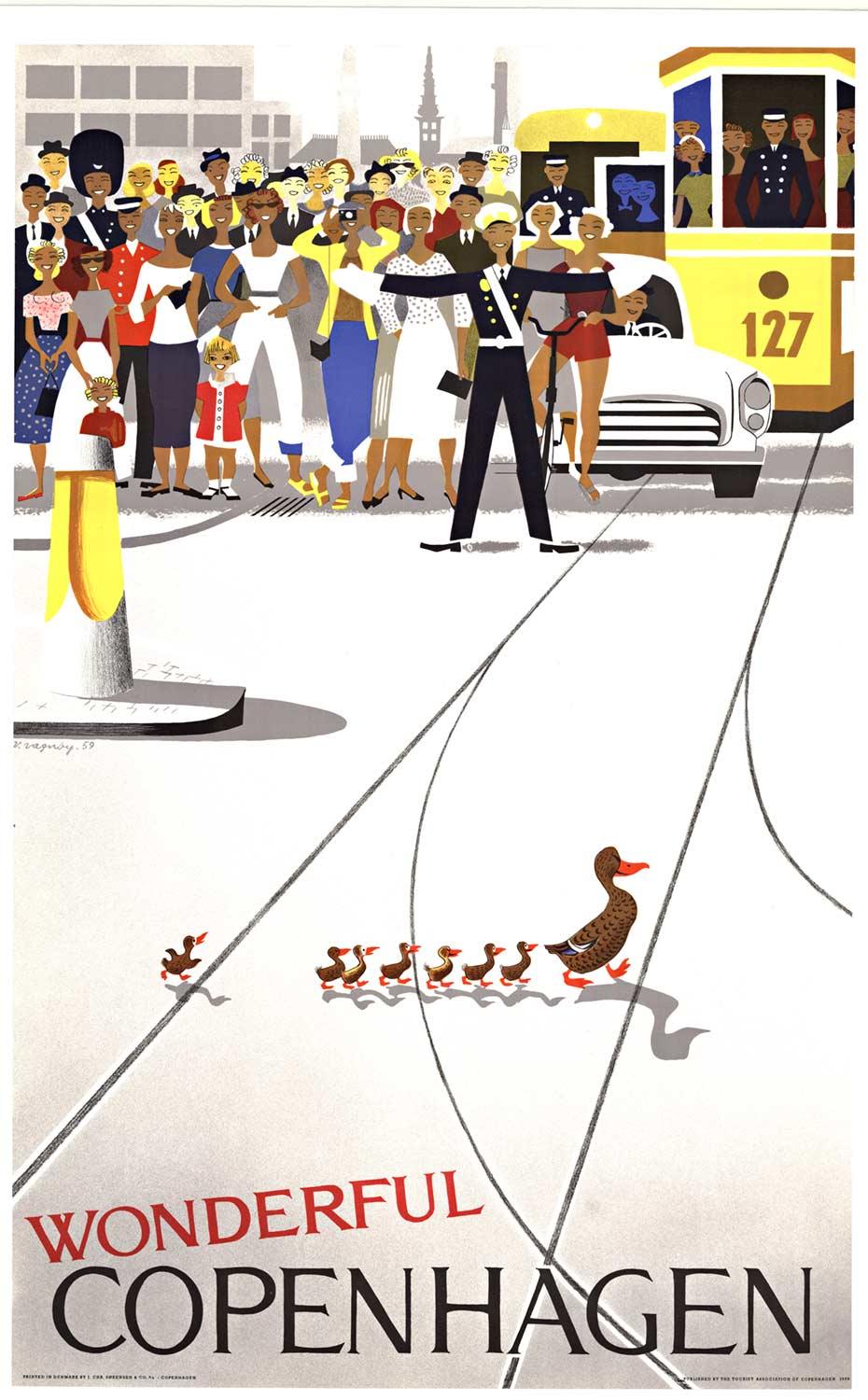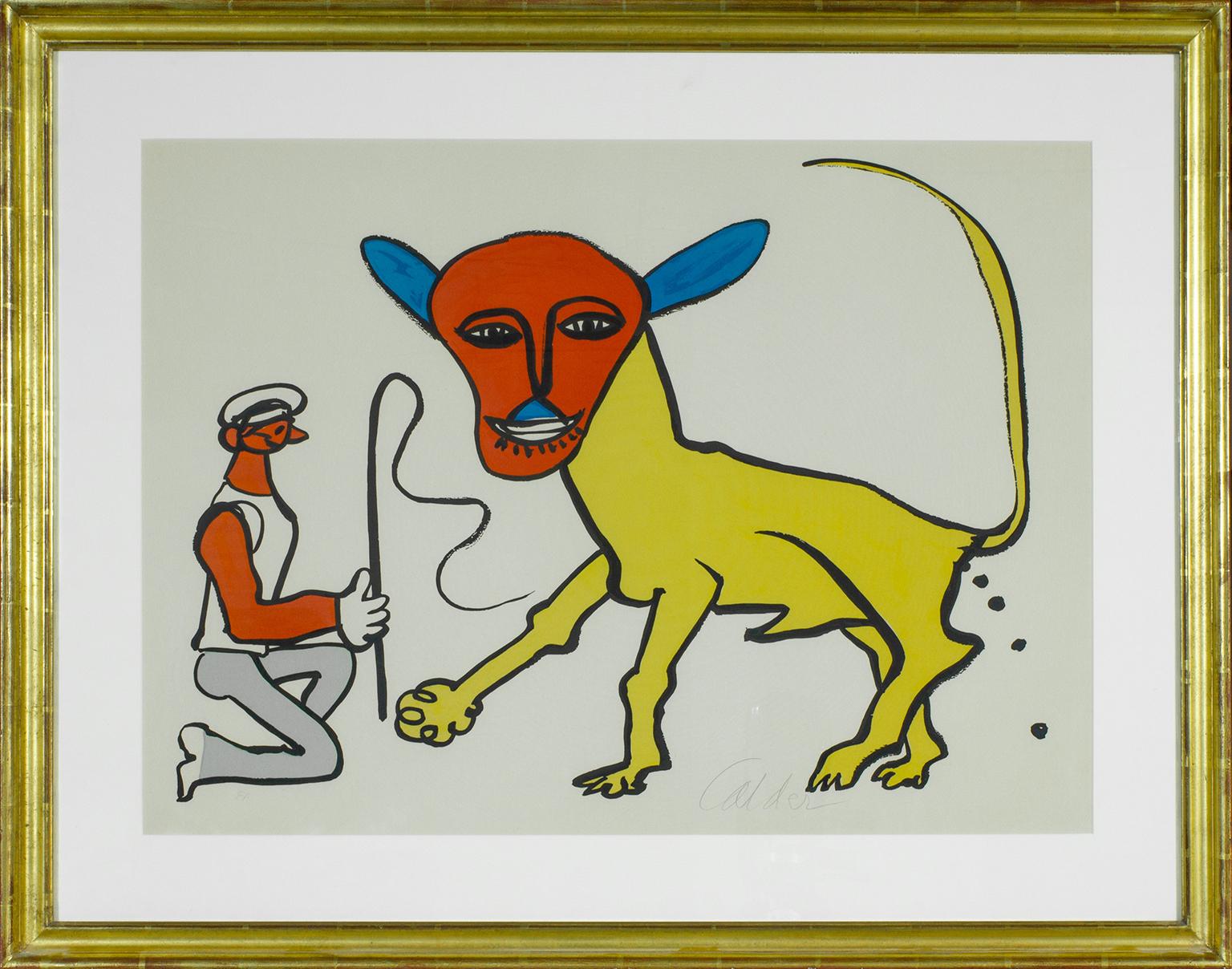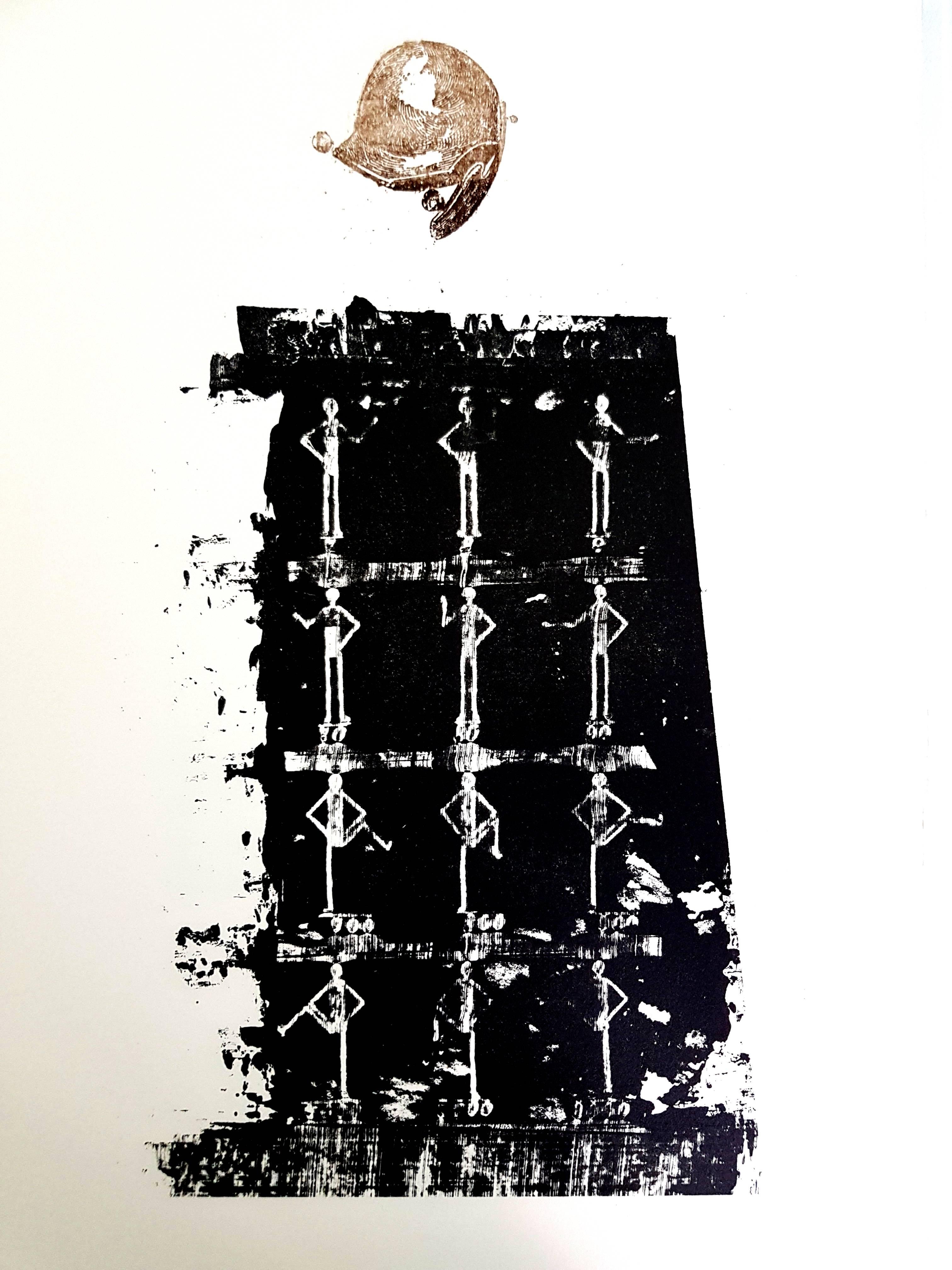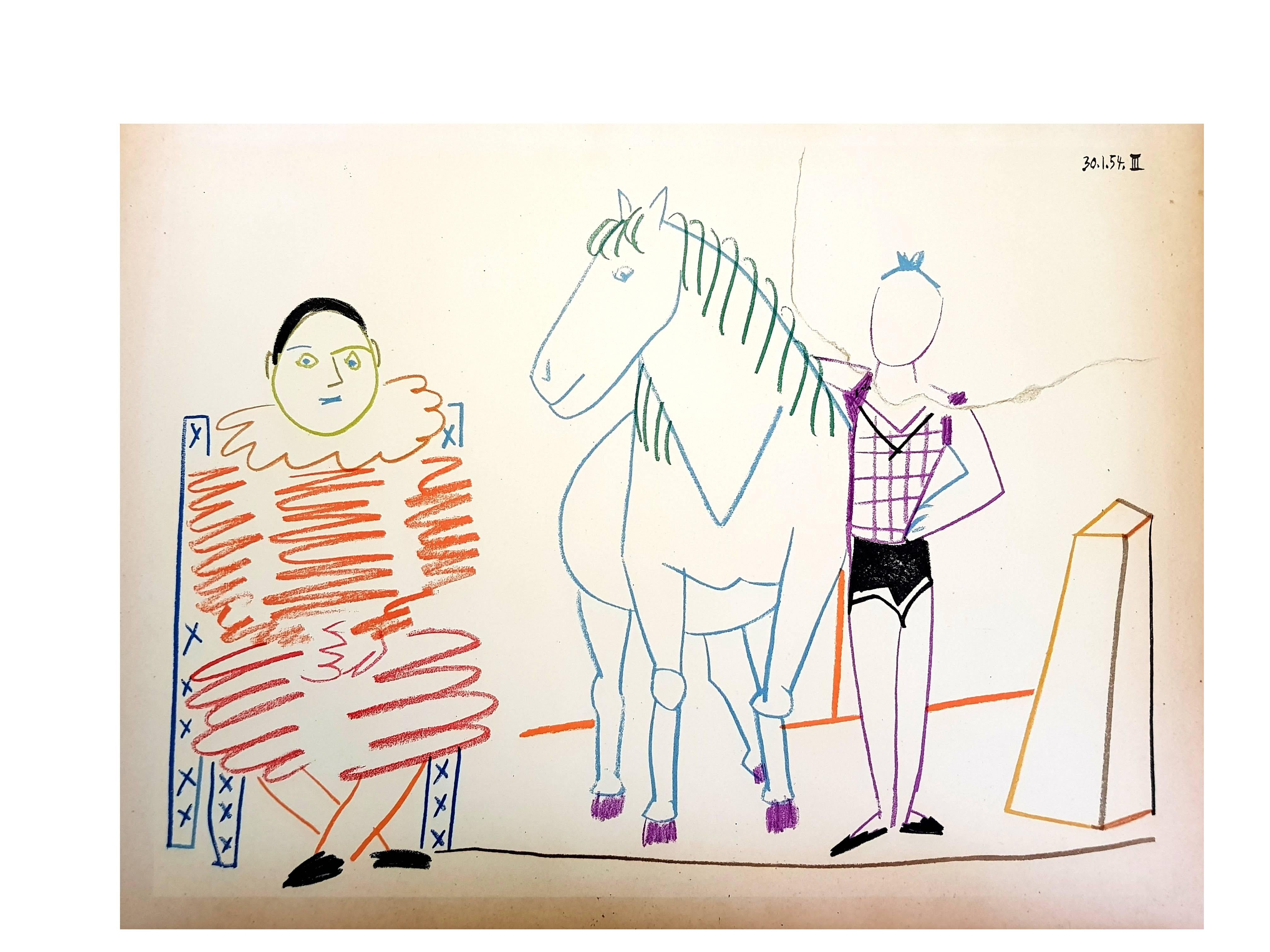Items Similar to Le Gôut du Bonheur: one plate
Want more images or videos?
Request additional images or videos from the seller
1 of 9
(after) Pablo PicassoLe Gôut du Bonheur: one plate1970
1970
About the Item
Artist: Pablo Picasso (after)
Medium: lithograph, Arches paper
Portfolio: Le Goût de Bonheur
Year: 1970
Edition: Total of 1998 copies (666 each in German, French and English)
Sheet Size: 13" x 10"
It was produced under the direct supervision of Pablo Picasso
Excellent Conditions
Picasso - Le Gout Du Bonheur - A Suite Of Happy, Playful And Erotic Drawings - This is the sole edition of re-creations that will ever be made of these unpublished drawings - three publishers have collaborated in its creation - the porfolios have been numbered from 1 to 666.
Picasso is not just a man and his work. Picasso is always a legend, indeed almost a myth. In the public view he has long since been the personification of genius in modern art. Picasso is an idol, one of those rare creatures who act as crucibles in which the diverse and often chaotic phenomena of culture are focussed, who seem to body forth the artistic life of their age in one person. The same thing happens in politics, science, sport. And it happens in art.
Early life
Born in Malaga, Spain, in October of 1881, he was the first child born in the family. His father worked as an artist, and was also a professor at the school of fine arts; he also worked as a curator for the museum in Malaga. Pablo Picasso studied under his father for one year, then went to the Academy of Arts for one year, prior to moving to Paris. In 1901 he went to Paris, which he found as the ideal place to practice new styles, and experiment with a variety of art forms. It was during these initial visits, which he began his work in surrealism and cubism style, which he was the founder of, and created many distinct pieces which were influenced by these art forms.
Updates in style
During his stay in Paris, Pablo Picasso was constantly updating his style; he did work from the blue period, the rose period, African influenced style, to cubism, surrealism, and realism. Not only did he master these styles, he was a pioneer in each of these movements, and influenced the styles to follow throughout the 20th century, from the initial works he created. In addition to the styles he introduced to the art world, he also worked through the many different styles which appeared, while working in Paris. Not only did he continually improve his style, and the works he created, he is well known because of the fact that he had the ability to create in any style which was prominent during the time.
Russian ballet
In 1917, Pablo Picasso joined the Russian Ballet, which toured in Rome; during this time he met Olga Khoklova, who was a ballerina; the couple eventually wed in 1918, upon returning to Paris. The couple eventually separated in 1935; Olga came from nobility, and an upper class lifestyle, while Pablo Picasso led a bohemian lifestyle, which conflicted. Although the couple separated, they remained officially married, until Olga's death, in 1954. In addition to works he created of Olga, many of his later pieces also took a centralized focus on his two other love interests, Marie Theresa Walter and Dora Maar. Pablo Picasso remarried Jacqueline Roque in 1961; the couple remained married until his death 12 years later, in 1973.
Work as a pacifist
Pablo Picasso was a pacifist, and large scale paintings he created, showcased this cry for peace, and change during the time. A 1937 piece he created, after the German bombing of Guernica, was one such influential piece of the time. Not only did this become his most famous piece of art work, but the piece which showed the brutality of war, and death, also made him a prominent political figure of the time. To sell his work, and the message he believed in, art, politics, and eccentricity, were among his main selling points.
Conflicting with social views
Many things Pablo Picasso did during the 1950s, conflicted with the general public. Viciousness towards his children, exaggerated virility towards women, and joining the Communist party, were some of the many scandals which he was involved in during his lifetime. Although most of the things he did were viewed negatively by a minority of the general public, admirers of Pablo Picasso turned a blind eye, and still accepted him as a prominent figure in their society. Following the end of WWII, Pablo Picasso turned back towards his classic style of work, and he created the "Dove of Peace." Even though he became a member of the Communist party, and supported Stalin and his political views and rule, Pablo Picasso could do no wrong. In the eyes of his admirers and supporters, he was still a prominent figure, and one which they would follow, regardless of what wrongs he did. He was not only an influence because of the works he created, but he was also an influential figure in the political realm.
Influence outside of art
Although Pablo Picasso is mainly known for his influence to the art world, he was an extremely prominent figure during his time, and to the 20th century in general. He spread his influences to the art world, but also to many aspects of the cultural realm of life as well. He played several roles in film, where he always portrayed himself; he also followed a bohemian lifestyle, and seemed to take liberties as he chose, even during the later stages of his life. He even died in style, while hosting a dinner party in his home.
Collection of work
Pablo Picasso is recognized as the world's most prolific painter. His career spanned over a 78 year period, in which he created: 13,500 paintings, 100,000 prints and engravings, and 34,000 illustrations which were used in books. He also produced 300 sculptures and ceramic pieces during this expansive career. It is also estimated that over 350 pieces which he created during his career, have been stolen; this is a figure that is far higher than any other artist throughout history.
Sale of his works
Pablo Picasso has also sold more pieces, and his works have brought in higher profit margins, than any other artist of his time. His pieces rank among the most expensive art works to be created; with a price tag of $104 million, Garson a la Pipe, was sold in 2004.
Although he had a conflicting lifestyle, Pablo Picasso was admired by many, and was one of the most influential figures of his time. Not only during his life, but also after his death, he is still one of the most well known artists, and political figures, of his time. With thousands of pieces to his name, and art works which have been seen by millions, around the world, he has been a great influence to society, he has influenced the art world, and he introduced many new styles of art, which helped shape modern art, and modern styles artists follow today.
- Creator:(after) Pablo Picasso (1881 - 1973, Spanish)
- Creation Year:1970
- Dimensions:Height: 13 in (33.02 cm)Width: 10 in (25.4 cm)Depth: 0.1 in (2.54 mm)
- Medium:
- Movement & Style:
- Period:
- Condition:
- Gallery Location:Collonge Bellerive, Geneve, CH
- Reference Number:1stDibs: LU16122543783
About the Seller
4.9
Gold Seller
These expertly vetted sellers are highly rated and consistently exceed customer expectations.
Established in 2015
1stDibs seller since 2015
908 sales on 1stDibs
Typical response time: 1 hour
- ShippingRetrieving quote...Ships From: Collonge Bellerive, Geneve, Switzerland
- Return PolicyA return for this item may be initiated within 7 days of delivery.
More From This SellerView All
- Max Ernst - The Soldier - Original LithographBy Max ErnstLocated in Collonge Bellerive, Geneve, CHMax Ernst (1891-1976) Georges Ribemont-Dessaignes, La Ballade du Soldat, Pierre Chave, Vence, 1972 Colour lithographs on Arches paper 1972 Edition : 199 Dimensions: 40 x 30 cm Refe...Category
1970s Modern Figurative Prints
MaterialsLithograph
- Max Ernst - The Soldier - Original LithographBy Max ErnstLocated in Collonge Bellerive, Geneve, CHMax Ernst (1891-1976) Georges Ribemont-Dessaignes, La Ballade du Soldat, Pierre Chave, Vence, 1972 Colour lithographs on Arches paper 1972 Edition : 199 Dimensions: 40 x 30 cm Refe...Category
1970s Modern Figurative Prints
MaterialsLithograph
- Enrico Baj - LithographBy Enrico BajLocated in Collonge Bellerive, Geneve, CHEnrico Baj - Original Lithograph Colorful Abstraction 1962 From the art revue XXe Siecle Dimensions: 32 x 24 Edition: G. di San Lazzaro. Unsigned and unumbered as issuedCategory
1960s Modern Figurative Prints
MaterialsLithograph
- The Human Comedy - LithographBy (after) Pablo PicassoLocated in Collonge Bellerive, Geneve, CHAfter Pablo Picasso The Human Comedy - Lithograph after an original drawing, as published in the journal "Verve" Printed signature and date Dimensi...Category
1950s Modern Figurative Prints
MaterialsLithograph
- The Human Comedy - LithographBy (after) Pablo PicassoLocated in Collonge Bellerive, Geneve, CHAfter Pablo Picasso The Human Comedy - Lithograph after an original drawing, as published in the journal "Verve" Printed signature and date Dimensions...Category
1950s Modern Animal Prints
MaterialsLithograph
- Pablo Picasso - La Petite Corrida - Original LithographBy Pablo PicassoLocated in Collonge Bellerive, Geneve, CHPablo Picasso - Original Lithograph La Petite Corrida (The Small Bullfight) 1958 Edition of 2000, unsigned Published in the journal XXe Siecle Dimens...Category
1950s Modern Figurative Prints
MaterialsLithograph
You May Also Like
- Original "Wonderful Copenhagen" vintage travel posterLocated in Spokane, WAOriginal vintage poster: WONDERFUL COPENHAGEN created by the artist Viggo Vagnby. This antique poster is archival linen backed, in excellent co...Category
1950s American Modern Animal Prints
MaterialsLithograph
- "Lion Tamer" framed signed lithograph by Alexander Calder. Edition EA of 100.By Alexander CalderLocated in Boca Raton, FL"Lion Tamer" lithograph by Alexander Calder. Hand-lettered EA in lower left front corner. Hand-signed Calder in lower right front corner. From an ed...Category
1970s Modern Animal Prints
MaterialsLithograph
- Fetching the Doctor (In Haste for the Doctor)By Edmund BlampiedLocated in Storrs, CTFetching the Doctor (In Haste for the Doctor) 1930. Lithograph. Appleby Lithographs 24. 11 x 16 (sheet 13 3/8 x 18 1/2). Edition 50. Illustration used as a ...Category
Early 20th Century Modern Animal Prints
MaterialsLithograph
- Modern Israeli Lithograph Reuven Rubin Views Of Israel Judaica Crowing RoosterBy Reuven RubinLocated in Surfside, FLLithograph printed by Chez Daniel Jacomet, Paris, France 1960 offset lithograph in colors on Arches, signed in crayon on the justification sheet (this auction is just for the one lit...Category
1960s Modern Figurative Prints
MaterialsLithograph, Offset
- Alexander Calder Circus Reproduction Lithograph After a DrawingBy (after) Alexander CalderLocated in Surfside, FL(after) Alexander Calder "Calder's Circus" offset lithograph on wove paper after drawings by the artist Published by Art in America and Perls gallery in 1964 (from drawings done in the 1930's) these range slightly in size but they are all about 13 X 17 inches (with minor variations in size as issued.) These have never been framed. The outer folio is not included just the one lithograph. James Sweeny from the introduction “The fame of Calder’s circus spread quickly between the years 1927 and 1930. All the Paris art world came to know it. It brought him his first great personal success. But what was more important, the circus also provided the first steps in Calder’s development as an original sculptor” Clive Gray...Category
1930s American Modern Animal Prints
MaterialsLithograph
- Alexander Calder Circus Reproduction Lithograph After a DrawingBy (after) Alexander CalderLocated in Surfside, FL(after) Alexander Calder "Calder's Circus" offset lithograph on wove paper after drawings by the artist Published by Art in America and Perls gallery in 1964 (from drawings done in the 1930's) these range slightly in size but they are all about 13 X 17 inches (with minor variations in size as issued.) These have never been framed. The outer folio is not included just the one lithograph. James Sweeny from the introduction “The fame of Calder’s circus spread quickly between the years 1927 and 1930. All the Paris art world came to know it. It brought him his first great personal success. But what was more important, the circus also provided the first steps in Calder’s development as an original sculptor” Clive Gray...Category
1930s American Modern Animal Prints
MaterialsLithograph





